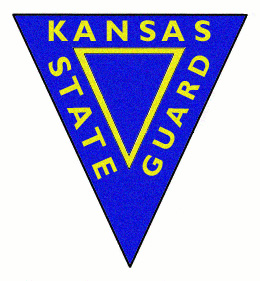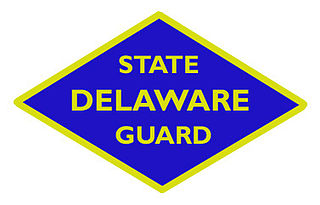
The Maryland Defense Force (MDDF) is the state defense force for the state of Maryland. The MDDF is organized as a state military reserve organization organized parallel to the Maryland National Guard and is designed to augment the National Guard during stateside emergencies. However, as a state defense force, the MDDF is solely under control of the State of Maryland and cannot be federalized or deployed outside the borders of Maryland.

The Louisiana National Guard is the armed force through which the Louisiana Military Department executes the U.S. state of Louisiana's security policy. Consisting of the Louisiana Army National Guard, a reserve component of the United States Army; the Louisiana Air National Guard, a reserve component of the United States Air Force; and the Louisiana State Guard, an all-volunteer state defense force, it is directed by an adjutant general appointed by the Governor of Louisiana unless federalized by order of the President of the United States, which places members on active U.S. military duty status.

The Wisconsin State Defense Force (WSDF) is the currently inactive state defense force of the State of Wisconsin authorized by Wisconsin law. As a state defense force, the Wisconsin State Defense Force, alongside the Wisconsin National Guard, is organized under the Wisconsin Department of Military Affairs as a part of the military forces of Wisconsin. However, unlike the National Guard, the State Defense Force is a purely state-controlled organization and cannot be deployed outside the state of Wisconsin. When any part of the Wisconsin National Guard is called into service of the United States, the adjutant general may recruit volunteers to the WSDF to serve within the borders of Wisconsin.

The Louisiana Air National Guard (LA ANG) is the aerial militia of the U.S. state of Louisiana. It is, along with the Louisiana Army National Guard, an element of the Louisiana National Guard.

The Arkansas State Guard was the official state defense force of the state of Arkansas during World War II. The Arkansas State Guard was created to fulfill the state missions of the Arkansas National Guard while the National Guard was deployed abroad during World War II. As a military unit trained and funded solely by the state, it was immune to federal activation and deployment, unlike the National Guard. As a part of the official militia of the state of Arkansas, it traces its roots back to the militias which fell under state authority prior to the Militia Act of 1903. The Arkansas State Guard is currently inactive following deactivation after the end of World War II; however, the legal framework for a state defense force still exists, making future reactivation of the Arkansas State Guard by the Arkansas General Assembly legally permissible.

The Tennessee State Guard (TNSG) is the state defense force of the state of Tennessee. The TNSG is organized as a military reserve force whose members drill once per month unless called to active duty. The TNSG is a branch of the Tennessee Military Department, alongside the Tennessee Army National Guard, the Tennessee Air National Guard, and the Tennessee Emergency Management Agency. The State Guard acts as a force multiplier for the state's National Guard. As a state defense force, the Tennessee State Guard cannot be federalized, and is not deployed outside the borders of Tennessee, as it is a purely state-level unit. It answers solely to the Governor of Tennessee, unlike the dual federal and state controlled National Guard. The creation of a state military force is recognized under Tennessee Code Annotated 58-1-401.

The Kansas State Guard was the official state defense force of the state of Kansas during each of the world wars. The unit was first created during World War I, and was later reactivated during World War II. When the Kansas National Guard was federalized and deployed during each of the world wars, the state of Kansas was forced to raise and maintain its own military force in order to protect against saboteurs, quell riots, and perform other duties which would normally fall to the National Guard. Unlike the National Guard, which could be federalized and deployed abroad, the State Guard was funded and equipped solely by the state and as such was immune to deployment. The Kansas State Guard is authorized under Kansas law. In 2007, the Kansas Legislature considered a bill which would create a modern Kansas State Defense Force. The bill did not pass.

The Florida State Guard (FSG) is the state defense force of the U.S. state of Florida. The FSG was created in 1941 to serve as a stateside replacement for the Florida National Guard while the National Guard was deployed abroad during World War II. The FSG is available to the governor of Florida whenever needed, but unlike the National Guard, the FSG is trained and funded by the state and therefore can not be federalized. The FSG was reactivated in 2022 after the Florida legislature appropriated US$10 million in funding.

The Delaware State Guard is the currently inactive state defense force of the state of Delaware, which was active during both World War I and World War II. As the official militia of the state, the Delaware State Guard was created with the intent of acting as a stateside replacement for the Delaware National Guard while the National Guard units were deployed abroad.

The Pennsylvania State Guard is the currently inactive official state defense force of the state of Pennsylvania, which was active during World War II and the Korean War. The unit was organized as a home guard composed of volunteers who were trained and organized as parallel to the state’s National Guard. As a part of Pennsylvania's official militia, the Pennsylvania State Guard was trained, organized, and funded by the state of Pennsylvania, answered to the governor, and could not be federalized or deployed abroad.
The Hawaii Territorial Guard was the state defense force of Hawaii during World War II. As a result of the National Guard of Hawaii being federalized for the duration of the war, the Hawaii Territorial Guard was created to serve as the stateside replacement for the National Guard. During the war, it was the sole military force available to the Governor of Hawaii as its captain general to use in defense of the state. Unlike the National Guard, as a state defense force, the Hawaii Territorial Guard was not subject to federalization or deployment outside of the borders of Hawaii, but rather answered only to the governor.
The Nebraska State Guard (NSG) is the currently inactive state defense force of the state of Nebraska, which was activated during both World War II and the Vietnam War. As a state defense force, the NSG served on as a component of the organized militia of Nebraska, serving as reservists who trained periodically but could be called up during an emergency; however, unlike the Nebraska National Guard, the Nebraska State Guard could not be federalized or deployed outside the state. Rather, when the National Guard was deployed, the purpose of the State Guard was to assume the stateside duties of the National Guard.

The Maine State Guard was the state defense force of the state of Maine during World War I, World War II, and the Vietnam War. As a state defense force, the State Guard served as a stateside replacement for the Maine National Guard when the National Guard was federalized. Like the National Guard, the State Guard was a reserve military force composed of members who held full-time civilian jobs and periodically met for drills, unless called into active service by the governor. However, unlike the National Guard, as a state defense force, the Maine State Guard was solely a state military force, which was immune from federalization and could not be deployed outside the State of Maine.

The Utah State Defense Force (USDF), formerly known as the Utah State Guard, is the currently unorganized state defense force of the state of Utah. The USDF, along with the Utah National Guard, is part of the organized militia of Utah. However, unlike the National Guard, the State Defense Force is by law solely under the command of the Governor of Utah and cannot be federalized or deployed outside the borders of Utah. Although inactive, Utah's State Defense Force Act allows the Governor to reactivate the USDF through executive action.

The New Hampshire State Guard (NHSG) is the currently unorganized state defense force of New Hampshire. The purpose of the State Guard is to augment or replace the New Hampshire National Guard by assuming the National Guard’s stateside duties when any part of the National Guard is federalized. However, unlike the National Guard, the State Guard is a purely state-level military force which cannot be federalized or deployed outside the state of New Hampshire. The NHSG is a component of the organized militia of New Hampshire.
The South Dakota State Guard is the currently inactive state defense force of South Dakota. The State Guard is recognized as a military force separate from the South Dakota National Guard. Unlike the National Guard, the State Guard is a purely state-level military force under the command of the Governor of South Dakota, and cannot be federalized or deployed outside the borders of the state. The South Dakota State Guard was active during World War I, World War II, and the Vietnam War and provided military protection to the state of South Dakota while the National Guard was in federal service.
The Iowa State Guard is the currently inactive state defense force of Iowa. The Iowa State Guard was organized during World War II in order to replace the Iowa National Guard which was federalized as a result of the war. The Iowa State Guard is recognized as a part of the organized militia of Iowa.

The Rhode Island State Guard is the currently inactive state defense force of Rhode Island. As a state defense force, the Rhode Island State Guard served as a state military unit which assumed the stateside duties of the Rhode Island National Guard when the National Guard was in federal service. However, unlike the National Guard, the State Guard, when organized, answers solely to the Governor of Rhode Island and by law cannot be federalized or deployed outside the borders of Rhode Island.
The Kentucky Active Militia was an official state defense force of Kentucky. It was created to assume the stateside duties of the Kentucky National Guard while the National Guard was in federal service during World War II.
The New Jersey State Guard, previously known as the New Jersey State Militia, is the inactive state defense force of New Jersey, and is one of New Jersey's authorized military forces. The State Guard served as the stateside replacement for the New Jersey National Guard during World War I and World War II when the National Guard was deployed abroad.















